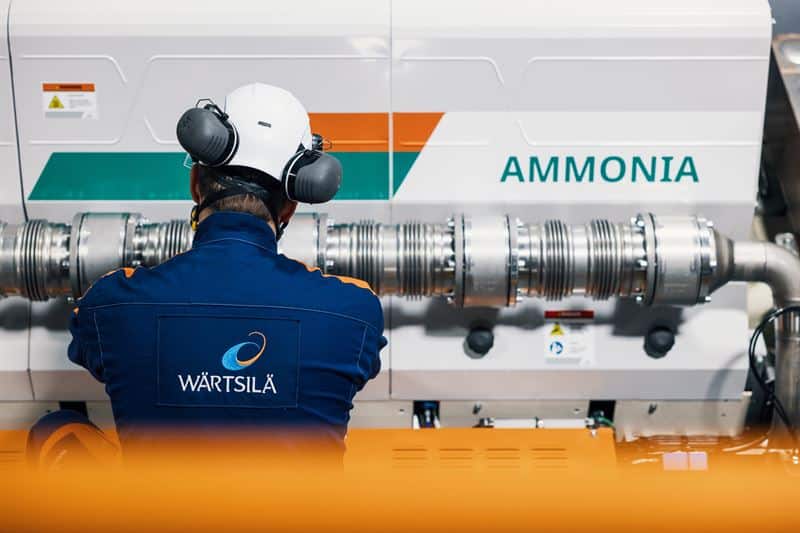Wärtsilä’s latest test data on its 4-stroke ammonia-fueled engine indicates a greenhouse gas (GHG) emissions reduction of up to 90% compared to conventional diesel engines, pushing the technology into closer alignment with the IMO’s mid-century decarbonization targets.
Introduced in late 2023, the Wärtsilä 25 ammonia engine is the first commercial marine engine from a major OEM to use a low-pressure Otto cycle for ammonia combustion—selected for its inherently lower ignition risks and efficiency parity with LNG-based dual-fuel systems. Recent testing has confirmed that the engine can operate on an ammonia energy share of up to 95%, offering a significant 18% performance improvement in emissions reductions compared to initial rollout metrics. These results are benchmarked both on a Tank-to-Wake and Well-to-Wake basis, aligning with FuelEU Maritime requirements.
Ammonia’s combustion profile, notably its high knock resistance and stable ignition across variable loads, has enabled Wärtsilä to push engine tuning beyond early-stage conservative parameters. Efficiency metrics from multiple engine sizes confirmed that ammonia can match LNG performance levels, while integrated system components—including the AmmoniaPac fuel supply module, NOx reduction (NOR) systems, and the WARMS (Wärtsilä Ammonia Release Mitigation System)—form a tightly engineered package designed to meet IMO Tier III and other emissions thresholds.
The use of a low-pressure system, rather than high-pressure direct injection, represents a deliberate trade-off to prioritise safety and operational manageability. Lower combustion temperatures and pressures mitigate the risk of uncontrolled reactions, which is especially critical given ammonia’s toxicity and corrosiveness. However, the reliance on a complete, proprietary ecosystem of supply, combustion, and exhaust management tools may pose challenges for third-party retrofitting and standardized maintenance regimes across fleets.
Despite its potential as a zero-carbon fuel, ammonia’s production remains limited by the current scale of green ammonia infrastructure. As of 2024, less than 1% of global ammonia output is classified as green, with the majority derived from fossil fuels. Wärtsilä’s Well-to-Wake emissions reductions assume the use of green ammonia, which, at present, is significantly more expensive than either LNG or marine diesel oil.
According to the International Energy Agency (IEA), green ammonia costs are projected to drop below $700 per tonne by 2030, assuming continued electrolyser cost declines and widespread policy support. However, this is still 2–3x higher than grey ammonia today and offers only limited commercial certainty for shipowners making fuel strategy decisions for vessels with 25–30 year lifespans.
Wärtsilä plans to deliver the first ammonia engines starting in 2026, but these will enter a fragmented regulatory landscape. While the IMO has adopted GHG intensity reduction targets and is expected to finalize a global fuel standard by 2027, port authorities and classification societies remain cautious. Standardized bunkering protocols for ammonia are still in development, and the lack of uniform international codes for toxic gas handling aboard ships may delay large-scale retrofitting or newbuild adoption.
The company’s strategy to embed ongoing enhancements into contracted engine orders shows flexibility in product lifecycle planning, but real-world deployment hinges on parallel investment in bunkering infrastructure, crew training, and regulatory harmonization.
A Wärtsilä-backed study estimates that fuel efficiency measures can only achieve up to 27% emissions reduction in shipping, leaving sustainable fuels to deliver the remaining 73%. Ammonia, alongside methanol and hydrogen, is expected to play a pivotal role—particularly for long-distance ocean freight where battery-electric or hybrid propulsion is infeasible.
Stay updated on the latest in energy! Follow us on LinkedIn, Facebook, and X for real-time news and insights. Don’t miss out on exclusive interviews and webinars—subscribe to our YouTube channel today! Join our community and be part of the conversation shaping the future of energy.
